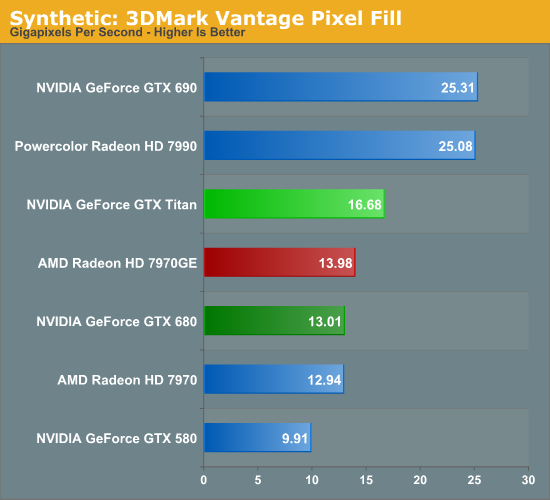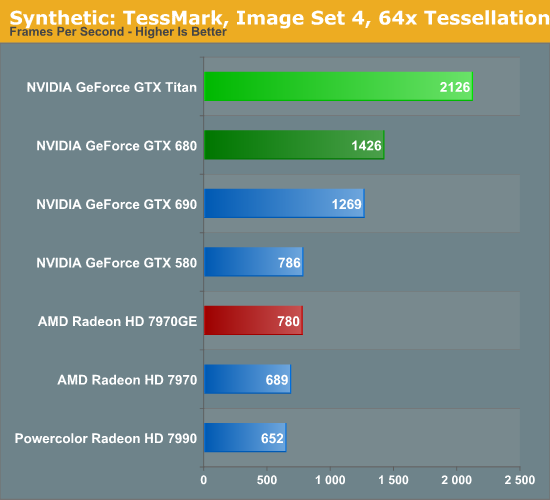NVIDIA’s GeForce GTX Titan Review, Part 2: Titan's Performance Unveiled
by Ryan Smith & Rahul Garg on February 21, 2013 9:00 AM ESTSynthetics
As always we’ll also take a quick look at synthetic performance to get a better look at Titan’s underpinnings. These tests are mostly for comparing cards from within a manufacturer, as opposed to directly comparing AMD and NVIDIA cards. We’ll start with 3DMark Vantage’s Pixel Fill test.

Pixel fill is a mix of a ROP test and a test to see if you have enough bandwidth to feed those ROPs. At the same time the smallest increase in theoretical performance for Titan over GTX 680 was in ROP performance, where a 50% increase in ROPs was met with a minor clockspeed reduction for a final increase in ROP performance of 25%.
The end result is that with gains of 28%, Titan’s lead over GTX 680 is just a hair more than its increase in theoretical ROP performance. Consequently at first glance it looks like Titan has enough memory and cache bandwidth to feed its 48 ROPs, which given where we’re at today with GDDR5 is good news as GDDR5 has very nearly run out of room.
Moving on, we have our 3DMark Vantage texture fillrate test, which does for texels and texture mapping units what the previous test does for ROPs.

Oddly enough, despite the fact that Titan’s texture performance improvements over GTX 680 were only on the range of 46%, here Titan is measured as having 62% more texturing performance. This may be how Titan is interplaying with its improved bandwidth, or it may be a case where some of the ancillary changes NVIDIA made to the texture paths for compute are somehow also beneficial to proper texturing performance.
Finally we’ll take a quick look at tessellation performance with TessMark.

Unsurprisingly, Titan is well ahead of anything else NVIDIA produces. At 49% faster it’s just a bit over the 46% theoretical performance improvement we would expect from the increased number of Polymorph Engines the extra 6 SMXes bring. Interestingly, as fast as GTX 580’s tessellation performance was, these results would indicate that Titan offers more than a generational jump in tessellation performance, nearly tripling GTX 580’s tessellation performance. Though at this time it’s not at all clear just what such tessellation performance is good for, as we seem to be reaching increasingly ridiculous levels.










337 Comments
View All Comments
etriky - Sunday, February 24, 2013 - link
OK, after a little digging I guess I shouldn't be to upset about not having Blender benches in this review. Tesla K20 and GeForce GTX TITAN support was only added to Blender on the 2/21 and requires a custom build (it's not in the main release). See http://www.miikahweb.com/en/blender/svn-logs/commi... for more infoRyan Smith - Monday, February 25, 2013 - link
As noted elsewhere, OpenCL was broken in the Titan launch drivers, greatly limiting what we could run. We have more planned including SLG's LuxMark, which we will publish an update for once the driver situation is resolved.kukreknecmi - Friday, February 22, 2013 - link
If you look at Azui's PDF, with using different type of kernel , results for 7970 are :SGEMM : 2646 GFLOP
DGEMM : 848 GFLOP
Why did u take the lowest numbers for 7970 ??
codedivine - Friday, February 22, 2013 - link
This was answered above. See one of my earlier comments.gwolfman - Friday, February 22, 2013 - link
ASUS: http://www.newegg.com/Product/Product.aspx?Item=N8...OR
Titan gfx card category (only one shows up for now): http://www.newegg.com/Product/ProductList.aspx?Sub...
Anand and staff, post this in your news feed please! ;)
extide - Friday, February 22, 2013 - link
PLEASE start including Folding@home benchmarks!!!TheJian - Sunday, February 24, 2013 - link
Why? It can't make me any money and isn't a professional app. It tells us nothing. I'd rather see photoshop, premier, some finite analysis app, 3d Studiomax, some audio or content creation app or anything that can be used to actually MAKE money. They should be testing some apps that are actually used by those this is aimed at (gamers who also make money on their PC but don't want to spend $2500-3500 on a full fledged pro card).What does any card prove by winning folding@home (same with bitcoin crap, botnets get all that now anyway)? If I cure cancer is someone going to pay me for running up my electric bill? NOPE. Only a fool would spend a grand to donate electricity (cpu/gpu cycles) to someone else's next Billion dollar profit machine (insert pill name here). I don't care if I get cancer, I won't be donating any of my cpu time to crap like this. Benchmarking this proves nothing on a home card. It's like testing to see how fast I can spin my car tires while the wheels are off the ground. There is no point in winning that contest vs some other car.
"If we better understand protein misfolding we can design drugs and therapies to combat these illnesses."
Straight from their site...Great I'll make them a billionaire drug and get nothing for my trouble or my bill. FAH has to be the biggest sucker pitch I've ever seen. Drug companies already rip me off every time I buy a bottle of their pills. They get huge tax breaks on my dime too, no need to help them, or for me to find out how fast I can help them...LOL. No point in telling me sythentics either. They prove nothing other than your stuff is operating correctly and drivers set up right. Their perf has no effect on REAL use of products as they are NOT a product, thus not REAL world. Every time I see the word synthetic and benchmark in the same sentence it makes me want to vomit. If they are limited on time (usually reviewers are) I want to see something benchmarked that I can actually USE for real.
I feel the same way about max fps. Who cares? You can include them, but leaving out MIN is just dumb. I need to know when a game hits 30fps or less, as that means I don't have a good enough card to get the job done and either need to spend more or turn things down if using X or Y card.
Ryan Smith - Monday, February 25, 2013 - link
At noted elsewhere, FAHBench is in our plans. However we cannot do anything further until NVIDIA fixes OpenCL support.vanwazltoff - Friday, February 22, 2013 - link
the 690, 680 and 7970 have had almost a year to brew and improve with driver updates, i suspect that after a few drivers and an overclock titan will creep up on a 690 and will probably see a price deduction after a few months. dont clock out yet, just think what this could mean for 700 and 800 series cards, its obvious nvidia can deliverTheJian - Sunday, February 24, 2013 - link
It already runs 1150+ everywhere. Most people hit around 1175 max OC stable on titan. Of course this may improve with aftermarket solutions for cooling but it looks like they hit 1175 or so around the world. And that does hit 690 perf and some cases it wins. In compute it's already a winner.If there is no die shrink on the next gens from either company I don't expect much. You can only do so much with 250-300w before needing a shrink to really see improvements. I really wish they'd just wait until 20nm or something to give us a real gain. Otherwise will end up with a ivy,haswell deal. Where you don't get much (5-15%). Intel won't wow again until 14nm. Graphics won't wow again until the next shrink either (full shrink, not the halves they're talking now).